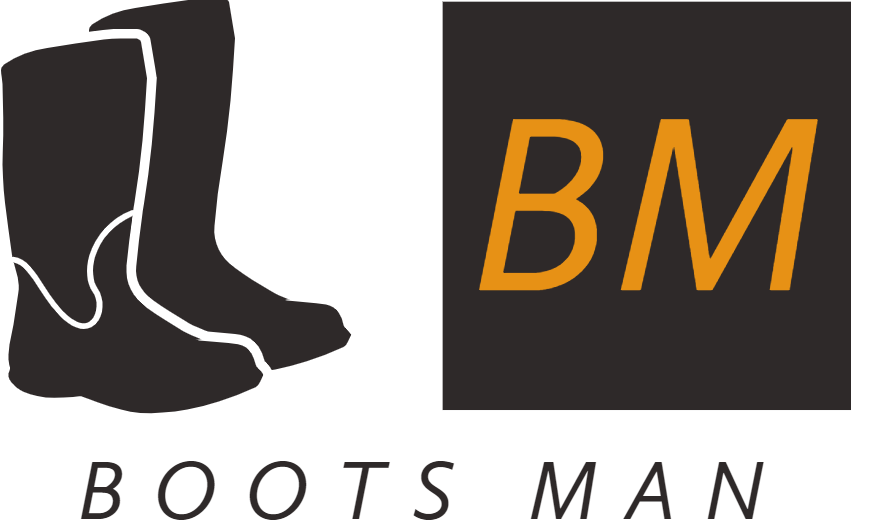Are you looking for boots to keep you safe and comfortable while working in a warehouse? You need boots that provide protection and support while being able to handle hours in harsh conditions.
In this guide, we’ll explore the best boots for warehouse work, so you can find the perfect fit for any environment.
Warehouse work can be physically demanding and assessing the right kind of footwear for the job is an important factor in workers’ health and safety. In this guide, we’ll explore the different features of boots that make them well-suited for warehouse work, comfort considerations for sensitive feet, and a few design tips to help your team stay safe on the job.
While there is no one-size-fits-all solution when it comes to finding appropriate footwear for the workplace; understanding how different features fit together to provide effective protection from hazards such as slipping, tripping and falling can help you make better purchasing decisions. We’ll start by looking at why boots are preferable to other types of shoes in warehouse settings.
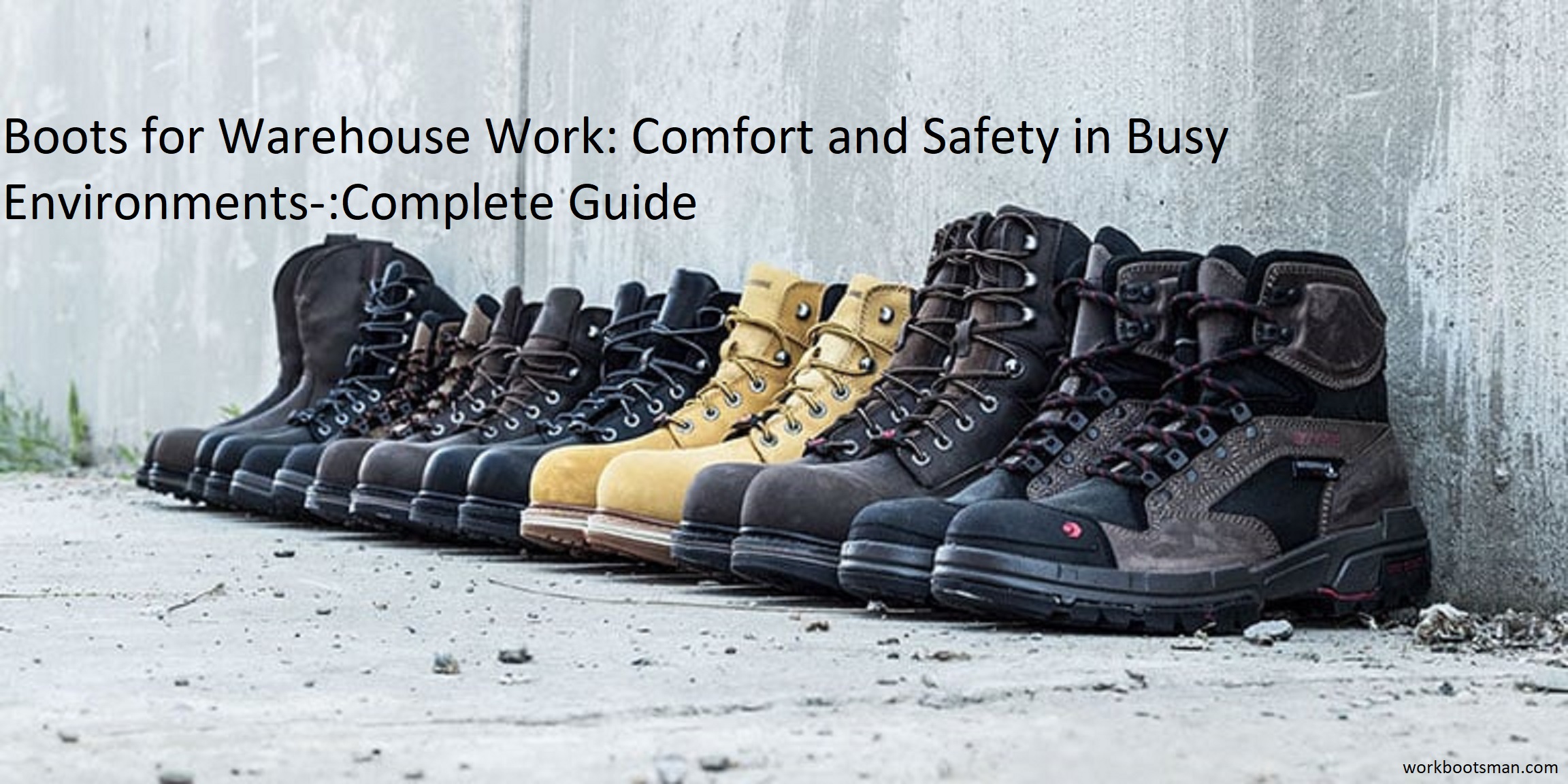
Comfortable Boots for Warehouse Work
When it comes to finding comfortable boots for warehouse work, look for durability as well as comfort. The boots need to be able to keep up with the demands of constant standing, walking and lifting with their cushioned interior and thick soles that can handle the rugged ground of a warehouse floor.
In addition to cushioning, the construction of the boot should include features such as: waterproofing, steel toes for protection from heavy objects being dropped onto feet, traction features on the outsole to prevent slipping on wet or oily floors; and breathable fabrics in layers that help keep feet dry in hot environments. There are many types of material available for warehouse-specific footwear including leather, cordura nylon and synthetic fabrics.
When deciding on a particular style of boot for warehouse work it is important to consider how often they will need replacing; low-cost fabric boots may not last as long but could be useful during busy periods or when starting out in a role due to their affordability; while higher quality leather boots may cost more initially but will last longer, often up to 2 years, even in tough working conditions.
Employers should supply adequate footwear so staff can meet occupational health and safety requirements comfortably; providing adequate foot protection that meets workplace standards is an important part of safe workplace practices and must be taken seriously by employers who have been entrusted with ensuring their staff is protected from injury or harm while at work.
Cushioned Insoles
Cushioned insoles are a key feature for many types of shoes, but they’re especially important when choosing boots suitable for warehouse work. Warehouse workers often spend long hours on their feet, and cushioned insoles help reduce fatigue and offer additional protection against shock absorption.
Look for a pair of boots with specific footbed cushioning and heel stabilizers that will keep your feet comfortable even during taxing shifts. Many work boot brands also offer extra-cushioned orthotic inserts as an aftermarket purchase to provide even more comfort and stability to workers who need it.
If you are planning on purchasing these inserts, it is important to have them properly fitted in order to ensure that you will get the most out of them.
Breathable Material
When it comes to breathable materials, we recommend avoiding synthetic thermoplastics like nylon and polyester etc. instead looking for natural, breathable materials such as suede leather and all types of textiles including reinforced cotton with a rubber, PVC or PU external coating.
These all have their advantages, but if you’re working in a busy environment for long hours then suede leather is arguably the best material as it is highly insulating so your feet won’t overheat as well as being naturally waterproof.
Also note that if you do choose to go with synthetics, then try to find footwear that has some sort of venting (usually in the form of air holes) so that your feet don’t get too hot during longer shifts.
Arch and Ankle Support
Good arch and ankle support is essential when considering boots for warehouse work. Look for cushioning across the arch of the foot, and an overall secure wrap around your foot and ankles.
It’s also important to pick boots with a reinforced toe box, as you can often run into obstacles on the floor in a rush of activity. Avoid boots with excessive padding that could interfere with your ability to move quickly on the job; instead, look for durable leather construction or composites like Kevlar that offer strength and flexibility at once.
It’s also a good idea to shop around for styles with breathable lining so your feet stay cool while in constant motion. Finally, make sure you test out any ankle supports in place, such as straps or braces, when trying on new boots to ensure they are comfortable and supportive enough for long days of work inside warehouses.
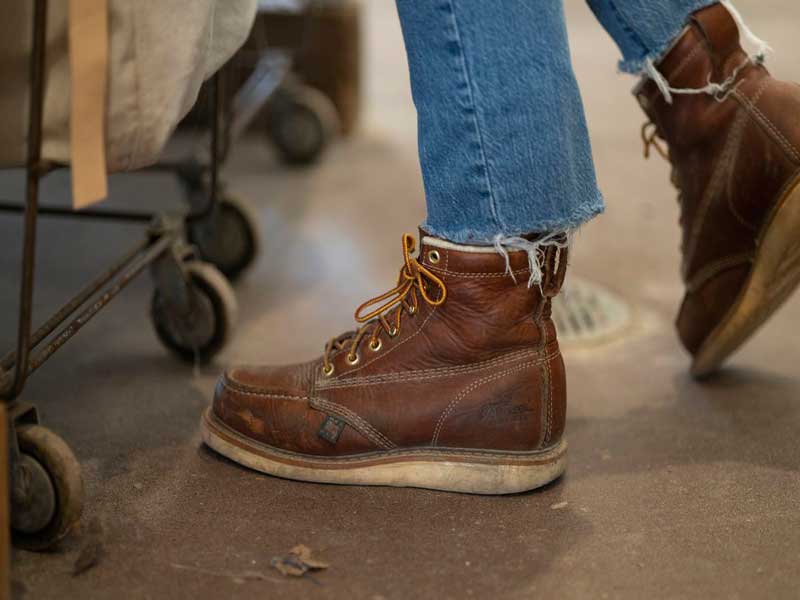
Safety Features to Look for in Warehouse Boots
Workers in warehouses and factories must have proper footwear to protect them from injury and keep them comfortable during long shifts. While choosing a pair of boots specifically for warehouse work, it is important to look for certain safety and comfort features. Here are some of the most common safety features to look for when purchasing warehouse boots.
Slip Resistance: Warehouse floors often involve hazards that regular shoes are not built to handle. Look for soles with slip-resistant treads and deep grooves, which help grip the slippery or uneven surfaces that are often encountered in industrial settings.
Toe Protection: Workers may encounter falling objects or other physical hazards at any moment on the warehouse floor. Look for a boot with steel toe caps or reinforced toes, which provide critical protection against compression injuries and cuts when performing manual labor tasks.
Oil & Chemical Resistance: Many warehouse workers operate around splashing liquids, chemicals, or oil puddles while doing their jobs. That’s why it’s important to ensure that the materials used in construction provide adequate resistance against potential fuel sprays, liquid splashes and chemicals gasses as well as high temperatures. Make sure your boots are up-to-date with appropriate flame retardants, ASTM/CSA ratings, nonconductive soles, insulation (for cold storage warehouses) certifications that meet OSHA standards if you work under hazardous circumstances.
Shock Absorption: Doing manual labor day after day can take a toll on worker’s feet – even with proper posture and technique! Luckily there are many boot styles specifically designed for comfort such as those featuring shock absorbing cushioning midsoles which can significantly reduce fatigue over long periods of time on hard surfaces without compromising grip or durability.
Steel Toe Caps
When selecting boots for warehouse work, steel toe caps should be your first priority. Steel toe caps can provide vital protection from hazardous objects that may come in contact with the feet while completing various tasks. Different types of protective toe caps are available, including composite material or non-metallic toes which can provide similar protection to that of steel but with lighter weight and flexibility.
Toe caps should be checked for certification to make sure they comply with safety standards and regulations, providing the highest level of protection in the event of an hazard. Additionally, good slip resistance on both soles and heels can help improve traction in slippery or wet conditions, preventing slips and falls which could result in injury.
Electrical Hazard Protection
For warehouse work, it is essential to invest in footwear that offers electrical hazard protection. Electrical Hazard (EH) certified shoes provide an additional layer of protection should you encounter live circuits, electrically energized conductors, parts or apparatus. The sole and upper of the shoe are designed to provide a secondary source of protection against accidental contact with live electrical circuits under certain dry conditions. It is important to note that these shoes are designed for incidental contact only and must be tested in accordance with industry safety regulations.
Look for safety footwear featuring an EH rating as well as the appropriate American Society for Testing and Materials (ASTM) tags, indicating that they have been laboratory-tested by an independent third party following industry-recognized standards of testing. According to the ASTM F2412 standard, there should be sufficient insulation between the outsole and foot bed on all EH rated footwear so that a minimum 100-megohm resistance range is achieved when the shoe insulator is tested according to ASTM D149 criteria.
It should be noted that environmental circumstances may significantly reduce this implied level of electrical hazard resistance over time and through wear; therefore, regular inspection of your safety boots is recommended for continued workplace safety.
Waterproofing
When choosing waterproof boots for warehouse work, it is important to select a sturdy, reliable pair that provides the right amount of insulation and slip resistance. Waterproofing ensures that your feet stay warm and dry even in wet environments, while slip resistance keeps you safe on slick surfaces.
Waterproof boots come in many styles with different levels of protection. The highest-grade boots are rated to keep water out for up to 8 hours and feature a vapour barrier layer between the inner shell and the outer material that prevents sweat from accumulating inside the boot. Some waterproofing options include urethane-coated leather, waxed leather, non-breathable synthetics such as neoprene or rubber, waterproofed canvas, Gore-Tex® and other vapor barriers, or totally waterproof soles using materials like Vibram® or Kerylex® rubber.
It is also important to choose a pair with enough insulation for your particular working environment. For example, if you’re going to be working outdoors in cold temperatures on wet surfaces then you’ll need additional protection from both dampness and cold. Choose boots made from Thinsulate™ or other similar materials to keep your feet at a comfortable temperature all day long.
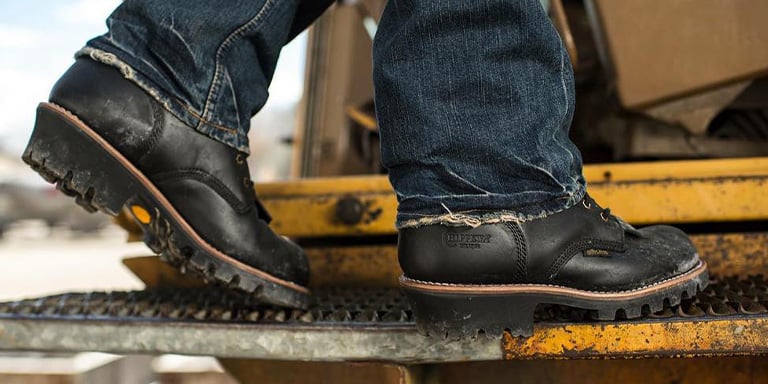
Boot Maintenance
Boot maintenance is critical to ensure your safety in the workplace. Regardless of the type of boot you choose, it’s important to take care of them and keep them in good condition at all times. Here are some tips for proper boot maintenance:
-Clean: After every use, clean your boots with a brush and mild soap or cleaning solution to remove debris gathered during the day. Allow them to dry completely before storing.
-Condition: Regularly condition leather boots with moisturizer or waterproofing spray so they last longer and remain flexible. Low cost waterproofing sprays can protect against water damage and salt stains, while using natural oils like lemon oil keep leather soft and conditioned.
-Polish: Buff light scratches while maintaining a nice shine on the boots by occasionally polishing with the correct product — matching wax or cream based on your own style of boot (whether it’s suede, glossy, waxed or smooth leather).
-Replace: Make sure you replace worn-out boots as they won’t provide adequate support in hazardous working conditions. Signs that indicate it is time for a new pair include noticeable tugging at the sole’s welt stitch and dried up eyelets that start cracking around edges.
Cleaning Techniques
Cleaning techniques are one of the most important considerations when purchasing boots for warehouse work. This not only ensures that floors remain in good condition but also helps to keep workers healthy, prevent wear and tear on the surface from dirt and debris, and reduce the risk of slips and falls.
When it comes to cleaning warehouse flooring, there are a few traits you should look out for in a shoe. A good-quality sole should be able to provide lasting protection against dirt, debris and grime while staying durable. It will also be essential to invest in shoes with non-marking soles – often made from rubber or other materials – which will help reduce scuff marks on the floor when workers move around the warehouse.
Additionally, having a shoe that is washable is also key as it will make cleaning them much quicker and easier than having to replace them. Some shoes can also come with certain coatings such as water repellency or antimicrobial treatments which can increase their life expectancy too.
Storage Tips
If you are in the market for boots to work in a warehouse, it is important to understand the importance of proper storage methods. Boots may start to deteriorate quickly if not taken care of correctly. This can lead to unnecessary wear and tear and can jeopardize your safety at work.
To get the most out of your boots, use these storage tips:
- Clean your boots thoroughly before storing them to remove any dirt or debris that may have built up during their use.
• Use a soft cloth or brush — never steel wool — to gently clean the leather and any synthetic materials used on your boots.
• Apply leather moisturizer or conditioner (for leather boots only) before storing them to help keep them supple and comfortable for when you put them on again for warehouse duty.
• For added protection, store your boots inside a plastic bag before putting them away in a closet or another enclosed space.
• Insert cedar inserts into the toes of boots while they are stored so they retain their shape while not being used.
• Stuffing extra paper inside of tightly fitted boots also helps preserve their shape while they’re not being worn.
• Store shoes away from direct sunlight, heat sources, wet areas, or moisture-rich environments so they stay in good condition for longer periods of time.
Inspection Guidelines
Inspecting your boots regularly is important for protecting yourself and others in a warehouse environment. Here are some tips to make sure that your warehouse boots are in good condition.
- Visually inspect boots on a daily basis for signs of damage. Look at the soles, laces, uppers, and linings for wear, nicks or cuts. Also, check straps and buckles if present
- Replace any lacing or hardware that shows signs of wear to ensure your safety from falls and trips.
- Check the sole flexibility and tread pattern of the shoes to ensure safe traction when walking on various surfaces utilizing the shoe’s gripping areas
- Bend each boot at both ends: a dry cracking sound coming from the leather is an indication that it may be time for a replacement pair
- Inspect toe boxes closely as they will be an indicator of whether you need additional cushioning or whether they are too restrictive
- Look into possibly purchasing an insertable orthotic if you have trouble with foot fatigue while wearing safety footwear
Proper inspections before wear can prevent pain and injury while on the job in bustling warehouses. Making sure that your safety shoes are in optimal condition will guarantee long-lasting comfort and help keep each work environment safe!
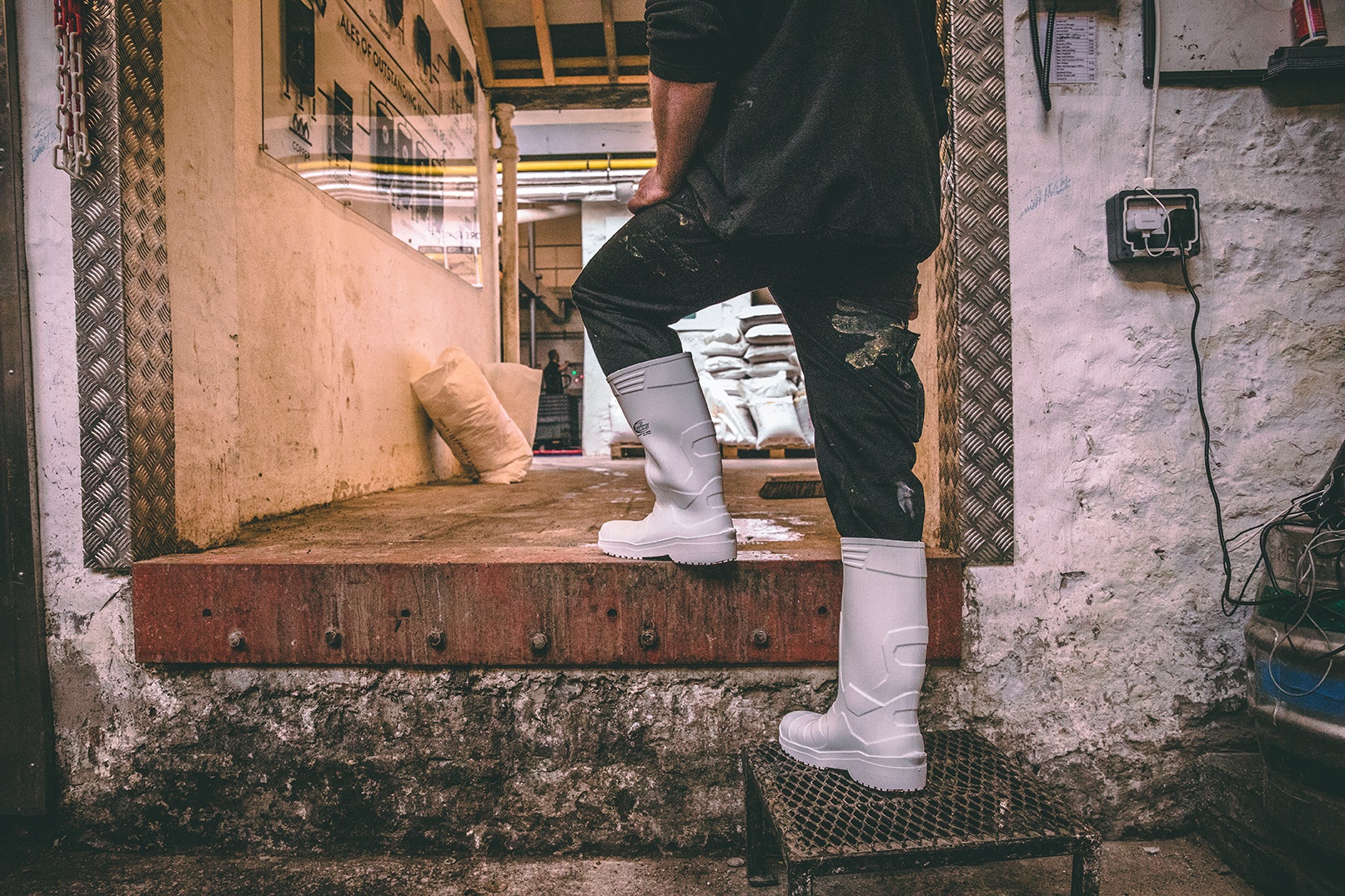
Conclusion
To summarize, when it comes to ensuring your feet are comfortable and safe in a warehouse environment, it’s important to make well-informed choices when it comes to selecting boots. Consider the type of material you need such as leather or synthetic; the durability needed; and protective features such as slip resistance, steel toes, and electric hazard protection.
Most importantly, make sure your boots fit properly and that you can move freely and safely in them. With these tips in mind, you can be sure that your feet will stay comfortable and protected during long days of work in the warehouse.
FAQs
What type of footwear should be worn in a warehouse environment?
Footwear that is appropriate for a warehouse environment should provide protection, comfort, and traction. Closed-toe shoes with a sturdy sole are usually recommended to protect feet from heavy objects or equipment that may fall or roll over them.
What are the best boots to wear in a warehouse?
Boots that are specifically designed for industrial or warehouse settings are usually the best option. They should have a reinforced steel toe, slip-resistant sole, and provide ankle support for maximum safety and comfort.
Do you need safety boots to work in a warehouse?
Yes, safety boots are often required to work in a warehouse. Employers have a legal responsibility to provide employees with personal protective equipment (PPE), including safety boots, to ensure their safety while on the job.
What are warehouse safety shoes?
Warehouse safety shoes are shoes that are designed to provide protection and safety for workers in a warehouse environment. They may have features such as steel toes, slip-resistant soles, and ankle support to help prevent injuries.
Should I wear boots to a warehouse job?
Yes, it is highly recommended to wear boots to a warehouse job, as they provide greater protection and safety than other types of shoes.
What should I wear to work in a warehouse?
Workers in a warehouse should wear clothing that is comfortable and allows for ease of movement, such as loose-fitting pants and a work shirt. Closed-toe shoes with a sturdy sole, such as boots or safety shoes, are also recommended.
What I can wear for work in a warehouse?
For work in a warehouse, it is best to wear clothing that is comfortable and practical. This may include loose-fitting pants or jeans, a work shirt or t-shirt, and sturdy boots or safety shoes.
What is the correct PPE for warehouse?
The correct PPE (personal protective equipment) for a warehouse may vary depending on the specific job and workplace, but typically includes safety shoes or boots, safety glasses or goggles, hard hats, and high-visibility vests.
What are the requirements for safety boots?
The requirements for safety boots may vary depending on local laws and regulations, but typically they must have a reinforced steel toe, slip-resistant sole, and provide ankle support. They should also be comfortable and fit properly.
Which category is best for safety shoes?
The best category for safety shoes may vary depending on the job and workplace, but typically safety shoes with a composite toe or steel toe, slip-resistant sole, and ankle support are recommended for maximum safety and protection.
See Also:
- Best hvac work boots 2023
- Best insoles for work boots on concrete 2023
- Best work boots for landscaping 2023
- Best work boots for mud 2023
- Best zipper work boots 2023
